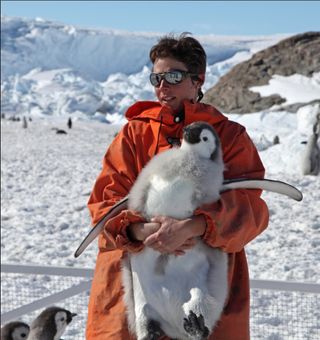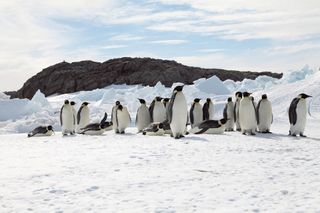Unhappy Feet: Global Warming Threatens Emperor Penguins

The biggest threat to emperor penguins may not be leopard seals or even killer whales, but a much larger predator: global warming.
Climate change, which is quickly melting the sea ice this species depends on for survival, could cause dramatic drops in the number of emperor penguins across Antarctica by the end of the century, a new study finds. Specifically, more than two-thirds of Antarctica's emperor penguin colonies will decline by more than 50 percent by the end of the century under future climate change scenarios.
The researchers, from France, the Netherlands and the United States, are pushing to have this iconic species listed as endangered before its numbers hit critical lows. Doing so, the researchers said, may establish "a new global conservation paradigm for species threatened by future climate change." [See Photos of Antarctica's Amazing Penguin Chicks]
The research, detailed yesterday (June 29) in the journal Climate Change, is based in part on a 50-year intensive study — supported by the French Polar Institute (IPEV) and Zone Atelier Antarctique (LTER France) — of an emperor penguin colony in Terre Adélie, East Antarctica. Researchers have been closely monitoring the Terre Adélie population each year, collecting biological measurements of the penguins there and charting the population's growth and decline.

"Long-term studies like this are invaluable for measuring the response of survival and breeding to changes in sea ice," said Hal Caswell, a scientist with the Woods Hole Oceanographic Institution (WHOI) in Massachusetts and the University of Amsterdam. "They provide our understanding of the role sea ice plays in the emperor penguin's life cycle."
Emperor penguins breed and raise their offspring almost exclusively on sea ice. And changes in sea ice concentration (SIC), or the relative area of water covered by sea ice, affect not only penguins, but also the entire Antarctic food web, down to the smallest of species, the researchers noted.
"The role of sea ice is complicated," said Stephanie Jenouvrier, a biologist with the WHOI, in a statement. "Too much ice requires longer trips for penguin parents to travel to the ocean to hunt and bring back food for their chicks. But too little ice reduces the habitat for krill, a critical food source for emperor penguins. Our models take into account both the effects of too much and too little sea ice in the colony area."
Sign up for the Live Science daily newsletter now
Get the world’s most fascinating discoveries delivered straight to your inbox.
Both Jenouvrier and Caswell have previously studied how changes in the concentration of sea ice might affect emperor penguin populations over the next several decades. In 2012, the two scientists and their team published a study in the journal Global Change Biology, which found that the Terre Adélie penguin population could decline by 80 percent by the end of this century. [Happy Feet: A Gallery of Pudgy Penguins]
For their newest study, the researchers expanded on this previous work, using the established population models from Terre Adélie to project how all 45 of Antarctica's known emperor penguin colonies would respond to future climate change. The projections included in the study are based on the current sea ice concentration and anticipated ones at each location.
The models take into account physical processes in the atmosphere, ocean, cryosphere and land surfaces.
"If sea ice declines at the rates projected by the IPCC [Intergovernmental Panel on Climate Change] climate models, and continues to influence emperor penguins as it did in the second half of the twentieth century in Terre Adélie, at least two-thirds of the colonies are projected to have declined by greater than 50 percent from their current size by 2100," Jenouvrier said. "None of the colonies, even the southern-most locations in the Ross Sea, will provide a viable refuge by the end of 21st century."
The colonies located between the Eastern Weddell Sea and Western Indian Ocean showed the largest declines, while those penguin colonies in the Ross Sea would experience the smallest decline. Some 20 percent of emperor penguin colonies will be nearly extinct by 2100, the analysis showed.
Based on their research, the study's authors found that the emperor penguin, which is currently under consideration for inclusion on the U.S. Endangered Species Act, is fully deserving of endangered status due to climate change. Securing the species a spot on the endangered species list, the researchers believe, could both protect this iconic animal and set a precedent for how to protect other species that are also affected by climate change.
"When a species is at risk due to one factor — in this case, climate change — it can be helped, sometimes greatly, by amelioration of other factors," Caswell said in the statement. "That's why the Endangered Species Act is written to protect an endangered species in a number of ways — exploitation, habitat, disturbance, etc. — even if those factors are not the cause of its current predicament."
For instance, listing the emperor penguin as endangered could lead to improved fishing practices of U.S. vessels in the Southern Ocean, as well as provide an impetus for reduction in emissions of the greenhouse gas carbon dioxide across the globe, Jenouvrier explained.
The researchers also point out that the Ross Sea, in the south of Antarctica, will be the last place impacted by climate change, and that conservation management strategies for emperor penguins should focus there.
Follow Elizabeth Palermo on Twitter @techEpalermo, Facebook or Google+. Follow us @livescience, Facebook & Google+. Original article on Live Science.

Elizabeth is a former Live Science associate editor and current director of audience development at the Chamber of Commerce. She graduated with a bachelor of arts degree from George Washington University. Elizabeth has traveled throughout the Americas, studying political systems and indigenous cultures and teaching English to students of all ages.
Most Popular


